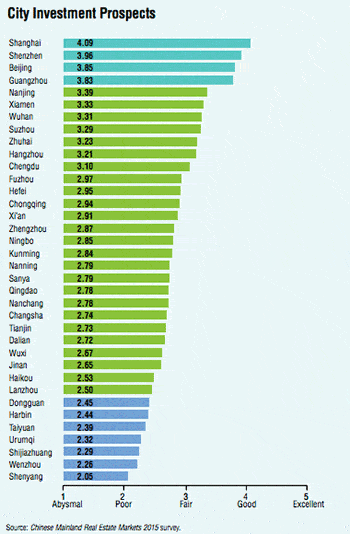 Shanghai ranked as the top Chinese city for real estate investment for the third year in a row, according to survey results released recently by the Urban Land Institute (ULI).
Shanghai ranked as the top Chinese city for real estate investment for the third year in a row, according to survey results released recently by the Urban Land Institute (ULI).
Despite what the real estate industry professional organisation referred to as rising optimism among its mainland members, that improving sentiment remains concentrated in China’s largest urban centres, as signified in the poll results. Following Shanghai in the ranking of most favored investment destinations were fellow mega-cities Shenzhen, Beijing, and Guangzhou. Nanjing in eastern China’s Jiangsu province was the only second-tier city to make it into the top five.
Enthusiasm for other developing cities in China was much more muted with the northern Chinese city of Shenyang ranking last for investment prospects among the 36 cities in the study.
First Tier Cities Leading the Way for Investment
Shanghai led the way for investment prospects on the mainland for the second year in a row, as all top five positions remained the same. However, second place Shenzhen scored much higher than last year with the survey respondents, closing much of the gap with its competitor in eastern China. ULI members cited the southern city’s influx of migrants, booming high tech sector and improving high speed rail links as reasons for Shenzhen’s move up the ranks.
Here’s the full top five cities for real estate investment in China in order, with their scores on a scale of 1 to 5, with 1 being “Abysmal,” and 5 being “Excellent.”
#!: Shanghai 4.09
China’s most populous city continued to inspire confidence among survey respondents, who singled it out as a future “global city,” which should eventually reach a par with global centres such as London, New York, and Tokyo.
#2: Shenzhen 3.96
Shenzhen’s ratings improved the most among the Tier 1 cities, driven largely by improvements in the office market, where vacancy rates declined to 4.6 percent in 2015 from 7.5 percent last year. Besides its migration and transportation advantages, the ULI report also noted that Shenzhen has benefitted from the growth of the Qianhai area as a special economic zone.
#3: Beijing 3.85
The capital’s top-performing sector continues to be office, which is fueled largely by the information technology industry, according to the report. The tight office market is leading to the conversion of other types of property for people who want to park their staff, desk and coffee machines, as well as in the emergence of decentralized office areas.
#4: Guangzhou 3.83
Receiving more mixed reviews compared with other Tier 1 cities, Guangzhou still ranked near the top for residential, office, retail and industrial. The report noted that the office market has now absorbed most of the substantial new supply created by the development of the Pearl River New Town and is supported by a growing IT sector. Retail and residential sectors in Guangzhou were rated as stable.
#5: Nanjing 3.39
Occupying the number five spot again this year, Nanjing made it into the top five despite being rated as only “fair” in investment prospects. However, the capital of Jiangsu province scored better on the ULI’s measures for new projects, receiving a rating of “good” for development.
According to Ken Rhee, co-author of the report and the ULI Chief Representative for the Chinese Mainland, “Tier 1 cities are increasingly popular with developers and investors for various factors including maturity of the markets, fast-growing service sector including the IT industry, and accelerating integration with nearby cities aided by high-speed rail.”
Only Nine Cities Got Panned
The report noted that its members who invest in real estate are “cautiously optimistic” about prospects for both investment transactions and new development projects in China’s first tier cities, as well as in the potential for some of its larger second tier urban areas.
The authors also pointed to a decrease in the number of smaller cities in China receiving a ranking of “poor” for their investment prospects, with only nine cities receiving the big thumbs down this year, compared to eleven in 2014.
The nine cities receiving that lowest level ranking from the institute’s members were, in descending order:
- Haikou, in Hainan province, 2.53 out of 5
- Lanzhou, in Gansu province, 2.50 out of 5
- Dongguan, in Guangdong province, 2.45 out of 5
- Harbin, in Heilongjiang province, 2.44 out of 5
- Taiyuan, in Shanxi province, 2.39 out of 5
- Urumqi, in Xinjiang province, 2.32 out of 5
- Shijiazhuang, in Henan province, 2.29 out of 5
- Wenzhou, in Zhejiang province, 2.26 out of 5
- Shenyang, in Liaoning province, 2.05 out of 5
Infrastructure Seen Driving Real Estate Values
Overall, this year’s edition of the annual survey, Chinese Mainland Real Estate Markets 2015, which ranks the real estate investment and development prospects of 36 of China’s most populous cities, showed a 5.7 percent increase in investor confidence in China’s prospects for property investment. For development, the study showed an improvement in sentiment of only one percent compared to last year.
In particular the study pointed to the country’s growing technology industry and efficiencies driven by the high speed rail and subway systems as improving real estate values.
The ULI’s research relied on written responses and interviews with leading domestic and foreign investors and developers active in China’s real estate markets, according to a statement by the organisation.
Leave a Reply